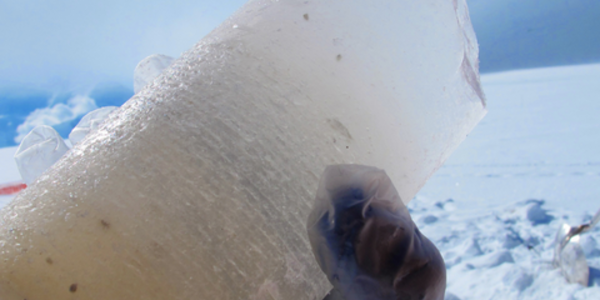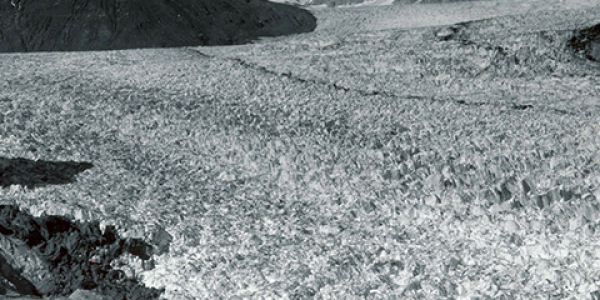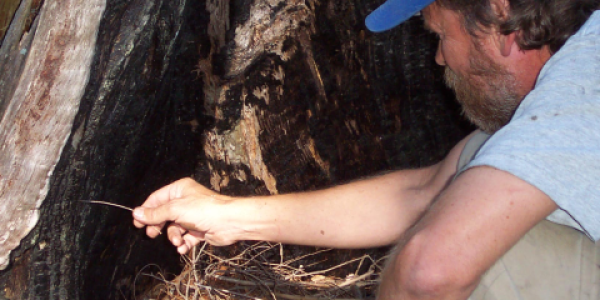
In paleoclimatology, or the study of past climates, scientists use what is known as proxy data to reconstruct past climate conditions. These proxy data are preserved physical characteristics of the environment that can stand in for direct measurements. Paleoclimatologists gather proxy data from natural recorders of climate variability such as corals, pollen, ice cores, tree rings, caves, pack rat middens, ocean and lake sediments, and historical data. By analyzing records taken from these and other proxy sources, scientists can extend our understanding of climate far beyond the instrumental record.
Historical Data
Historical documents, which are one type of proxy data, can contain a wealth of information about past climates. Observations of weather and climate conditions can be found in ship and farmers’ logs, travelers’ diaries, newspaper accounts, and other written records. When properly evaluated, historical documents can yield both qualitative and quantitative information about past climate. For example, scientists used historical grape harvest dates to reconstruct summer temperatures, between April and September, in Paris from 1370 to 1879.
Corals
Another type of proxy data, corals build their hard skeletons from calcium carbonate—a mineral extracted from seawater. The density of these calcium carbonate skeletons changes as the water temperature, light, and nutrient conditions change, giving coral skeletons formed in the summer a different density than those formed in the winter. The carbonate also contains isotopes of oxygen as well as trace metals that can be used to determine the temperature of the water in which the coral grew. Scientists can then use this information to reconstruct the climate when the coral lived.
Pollen
All flowering plants produce pollen grains, which are another type of proxy data. Scientists can use the distinctive shapes of pollen grains to identify the type of plant from which they came. Since pollen grains are well preserved in the sediment layers in the bottom of a pond, lake, or ocean, an analysis of the pollen grains in each layer tells scientists what kinds of plants were growing at the time the sediment was deposited. Scientists can then make inferences about the climate of the area based on the types of plants found in each layer.
Ice Cores
Located high in the mountains and near the poles, ice—another type of proxy data—has accumulated from snowfall over many millennia. Scientists drill through the deep ice to collect ice cores, which often have distinct layers in them. These layers contain dust, air bubbles, or isotopes of oxygen, differing from year to year based on the surrounding environment, that can be used to interpret the past climate of an area. Ice cores can tell scientists about temperature, precipitation, atmospheric composition, volcanic activity, and even wind patterns.
Tree Rings
Trees and their unique rings also serve as proxy data. Because climate conditions influence tree growth, patterns in tree-ring widths, density, and isotopic composition reflect variations in climate. In temperate regions where there is a distinct growing season, trees generally produce one ring a year, recording the climate conditions each year. If they depend heavily on warm temperatures or lots of moisture in the growing season, their rings will be wider when those conditions are present and narrower when they aren’t. Trees can also grow to be hundreds to thousands of years old and can contain annual records of climate for centuries to millennia.
Caves
Caves and the unique rock formations inside them also serve as proxy data. These underground chambers contain the secrets of Earth’s climate in speleothems—also known as stalactites, stalagmites, and other formations. Speleothems grow over time as water drips down from a cave’s ceiling or pools in its floor and mineral deposits build up in thin, shiny layers. Because the amount of water making its way into caves determines the amount speleothems grow, their layers can indicate times of both heavy precipitation and drought.
Pack Rat Middens
Plant-rich deposits called pack rat middens are another type of proxy data. To produce these middens, pack rats gather plant materials at close range and accumulate them in dry caves and crevices. There, those plant materials and other debris are cemented by large masses of crystallized urine and can be preserved for tens of thousands of years. After collecting, cleaning, and sorting midden samples, scientists analyze their contents, which represent the local environment at the time the material was gathered.
Ocean and Lake Sediments
Another type of proxy data can be found on the floors of Earth’s oceans and lakes. Billions of tons of sediment accumulate in ocean and lake basins each year, providing a vast amount of information about the environment. Scientists drill cores of the sediments from the basin floors and examine their contents, which include tiny fossils and chemicals, to interpret past climates.
These are just a few examples of the environmental recorders scientists can use to learn about ancient climates.



